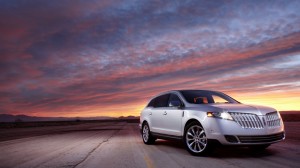
The Lincoln MKT, one of the brand's newest offerings, will soon be followed by seven other all-new or significantly redesigned offerings.
This past weekend saw the launch of a new ad campaign and an all-new tagline for Ford’s long-struggling Lincoln brand. “Smarter Than Luxury,” as it’s been dubbed, will emphasize the Detroit marque’s technology – with features like the voice-activated Sync system.
The goal is to “challenge people’s perception,” by emphasizing technology, style and craftsmanship,” explains Matt VanDyke, Lincoln’s marketing communications director.
But senior company officials admit that no advertising campaign alone will be enough to right what’s been wrong with Lincoln, a brand that must stand on its own, now more than ever. And that means a dramatic shift in product direction that will begin to surface over the next several years, company insiders hint, as well as a restructuring of the Lincoln distribution network.
A decade ago, Lincoln was a virtually forgotten brand. Former Ford Chief Executive Jacques Nasser was lining up an assortment of import marques, such as Volvo and Land Rover, which would form the core of the new Premier Automotive Group. Lincoln was all but sneered at, the company suggesting it would serve as a “blue-collar luxury” brand, for those less demographically desirable buyers who somehow managed to scrape together enough money to acquire a premium model.
Since CEO Alan Mulally took the helm four years ago, however, Ford has sold off its various PAG marques and, more recently, decided to close the moribund Mercury brand, which had long been paired with Lincoln. So, Ford has realized, the company’s only remaining luxury nameplate has to get a new direction – and the resources to make it work.
Lincoln has rolled out a number of new products over the last several years, including the distinctive, if controversial MKT crossover. And the maker plans to introduce seven all-new or signficantly redesigned models over the next four years.
The brand “has to be fully competitive,” Ford Motor Co.’s marketing chief, Jim Farley, told TheDetroitBureau.com, during an interview at the Paris Motor Show. And that means, “the product has to stand for something that’s worth the premium price.”
The distinctive Sync system, considered perhaps the most customer-friendly yet expansive infotainment system on the market, is certainly a plus, the company believes. Internal data suggest that Ford and Lincoln dealers have had significant success winning over skeptical buyers by demonstrating the technology.
But that assumes those customers have first chosen to visit a Lincoln showroom, and that is, in itself, a challenge to achieve. Not that it’s impossible, insists Farley. He points to the success of one of Lincoln’s Asian competitors. The Infiniti division was long relegated to the second tier of luxury brands. But since the launch of its latest G-Series it has risen in the ranks. It is a “compelling example,” suggests Farley, that with the right products a brand can “become viable again.”
Like Infiniti, Farley suggests, the revitalization of Lincoln will focus on the entry-luxury niche, which today accounts for an overwhelming share of sales. A compact sedan is under development, and will help position Lincoln against the likes of the Audi A3 and BMW 1-Series.
Technology will be more and more important, but what Lincoln is now working on, he stresses, is coming up with “the essence of the brand.”
Details are sketchy and for good reason, the executive says. Lincoln plans to outline its new direction during a meeting with its 1,187 dealers scheduled for the coming week.
That event is intended to build commitment to the brand. If retailers see a future for Lincoln they’ll be more likely to commit dollars to upgrading showrooms and manpower to push the product.
But not everyone will likely walk away feeling good about the brand’s new direction. Though Farley pointedly declined to discuss specifics, reports circulating around the industry suggest that as many as 200 Lincoln dealers could be eliminated in a marketing realignment.
One of the challenges faced by Ford with Mulally’s back-to-basics strategy is that the company no longer has a global luxury brand. Lincoln doesn’t even have the modest presence abroad of its cross-town rival, Cadillac. And despite long-running discussions of ways to reach beyond U.S. shores, that isn’t likely to happen soon, cautions Ford’s global design chief, J Mays.
“Lincoln is still five to six years away from launching products that have (global) credibility,” Mays cautioned during a Paris interview. “If, when we launch products that have that credibility maybe then we can have that conversation.”
